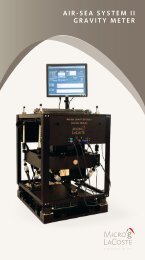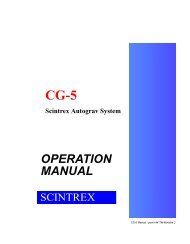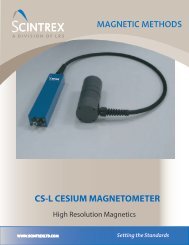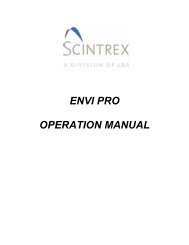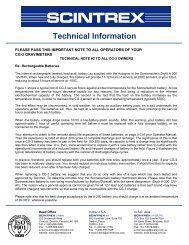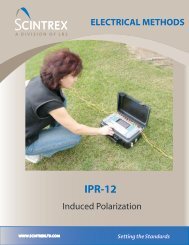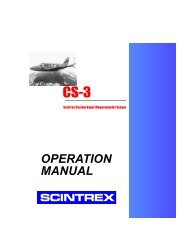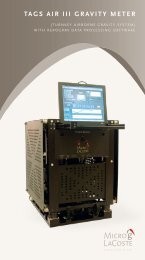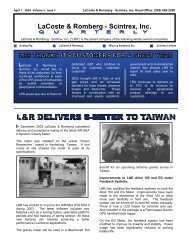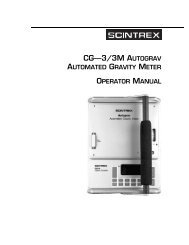CG-3 Description & Test Results - Scintrex
CG-3 Description & Test Results - Scintrex
CG-3 Description & Test Results - Scintrex
You also want an ePaper? Increase the reach of your titles
YUMPU automatically turns print PDFs into web optimized ePapers that Google loves.
Prior to the commencement of each reading, a softwarecontrolled procedure calibrates the A/Dconverter, using a highstability internal voltage reference. When the calibration is completed, the A/Dconverter samples the gravity sensor output every second. The individual samples are averaged to filterout seismic noise. The standard deviation of the mean of the samples is displayed in realtime.Corrections for tilts, sensor temperature and longterm drift are made every second during the reading. Astatistical rejection criterion is used to discard any noise spikes. A tide correction is applied at the end ofthe reading. (These last two functions can be disabled from the keyboard.)When a measurement is completed the gravity reading is stored in the memory along with nine othervariables. These are: station number, standard deviation of the mean; tilts (X and Y); sensortemperature; tide correction; reading duration; number of rejected samples; time of start of reading. Allcurrent and stored data can be viewed on the LCD display, using the scroll feature on the keyboard.As well, additional information can be entered at the time of measurement for recording in memory.Eight blocks of data, each containing up to a fivedigit signed number, can be stored with each reading.The standard memory stores up to 420 readings and can be expanded to a maximum of 1260 readings.The memory is protected for several days in the event of battery failure.Other information is also generated and is accessible through the display, including time, date, batteryvoltage and available memory space.The instrument is equipped with an RS232 interface. This enables data from the memory to be accessedthrough a connector on the instrument front panel. Output of selected portions or of the entire contentsof the memory can be obtained in the form of a data listing or as a plot, which can be printed out directlyon to a line printer, transferred to a portable computer or tape recorder or transmitted over a telephoneline to a modem.Header information consisting of survey parameters and instrument constants is shown at the top of eachdata listing (fig. 3). Each gravity reading is located by station number and time. The record of the othervariables facilitates data quality control. For example, the record of tilts indicates if the instrument hasbeen properly levelled; sensor temperature shows if the thermostat is functioning correctly; the standarddeviation of the mean (ERR) and the number of rejections indicate the noise level at the measurementsite.6



